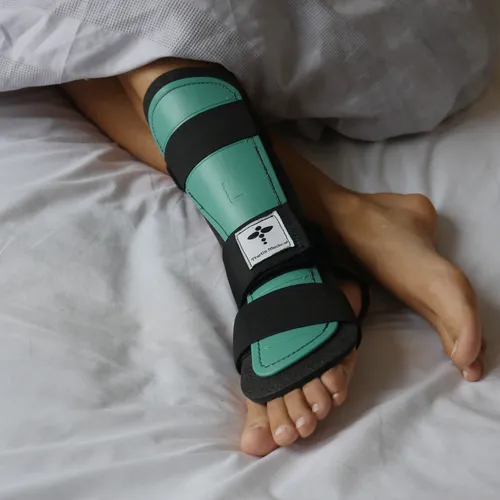Achilles Rupture Rehabilitation: Complete Recovery Guide & Exercise Program
Get the full eBook on Achilles tendon ruptures FREE.
Find your answer:
Achilles rehab timeline – what happens each week?
When can I start physiotherapy?
When is it safe to put weight on my foot?
Best home exercises after an Achilles rupture
When can I drive again?
How do I progress from walking to running?
Products that make rehab easier
Top tips to avoid re-rupture
Achilles rehab timeline – what happens each week?
Recovery usually follows a week-by-week roadmap:
- Weeks 0-2: Boot in tip-toe (equinus) position, partial weight-bearing.
- Weeks 2-6: Gradual heel-wedge reduction, full weight-bearing, begin gentle isometrics.
- Weeks 6-10: Transition out of boot, double then single-leg heel raises.
- Months 3-6: Running drills and sport-specific training.
- 6+ months: Return to competition once calf strength ≥90% of the other side.
When can I start physiotherapy?
Most protocols introduce guided physio around week 2-3 for simple ankle range-of-motion and seated calf activation. By weeks 6-10 you'll progress to resistance bands and load-bearing heel raises.
When is it safe to put weight on my foot?
Evidence supports early protected weight-bearing in a boot as soon as comfort permits – often within the first few days. This promotes tendon healing and reduces stiffness. Keep the foot pointed (don't let the ankle bend up) whenever you stand.
Best home exercises after an Achilles rupture
Remember: Always follow your physio's specific plan and stop if you feel sharp pain. Your timeline might be different based on your doctor's advice and how you're healing.
When can I drive again?
For right-sided injuries most surgeons recommend waiting until you can perform an emergency stop simulation in trainers – typically after week 8-10 once you're out of the boot. Left-sided injuries in an automatic car may return sooner. Check with your doctor and insurer first.
How do I progress from walking to running?
Start with a jog-walk programme: 1 min jog / 1 min walk x10 on a flat track when you can perform 25 single-leg heel raises pain-free. Gradually increase jog intervals and introduce direction changes.
Products that make recovery easier
• Achilles Rupture Splint – sleep comfortably without risking re-rupture.
• Full equipment guide compares boots, waterproof covers and more.
Top tips to avoid re-rupture
- Wear the boot or splint every night for the full 10 weeks.
- Remove the boot only when seated and never let the ankle bend up.
- Use crutches for balance until you can walk without a limp.
- Follow your physio's loading plan – calf strength is king.
Best home exercises after an Achilles rupture
- Light calf squeezes while sitting
- Small ankle circles (keep foot pointed down)
- Focus on keeping the wound clean and dry
- Hip and knee exercises with resistance bands
- Core strengthening exercises
- Upper body workouts to maintain fitness
- Start walking in your boot with heel wedges
- Practice proper walking technique
- Gradually increase walking distance
- Gentle ankle movements (keep knee bent)
- Light calf squeezes in different positions
- Stationary bike when wound is healed
- Two-legged heel raises on a step
- Seated calf raises with light weights
- Walking practice with less heel lift
- Basic squats and lunges
- Pool exercises for better movement
- Balance and stability exercises
- One-legged heel raises
- Jumping and hopping exercises
- Sport-specific movements
- Focus on smooth, natural movement
- Practice sport-specific skills
- Gradual return to full activity
- Week 8: Two-legged heel raises through full range
- Week 12: One-legged heel raises
- Week 16: Ready for dynamic activities
- Week 24: Return to sport (requires >90% strength)
- Always follow your physio's specific plan
- Stop if you feel sharp pain
- Timeline may vary based on individual healing
- Focus on quality of movement over speed of progress
Remember: Always follow your physio's specific plan and stop if you feel sharp pain. Your timeline might be different based on your doctor's advice and how you're healing.

Torn Achilles? Sleep Soundly with the Splint.
The Splint is designed for comfort and to protect your healing Achilles.
Buy Now